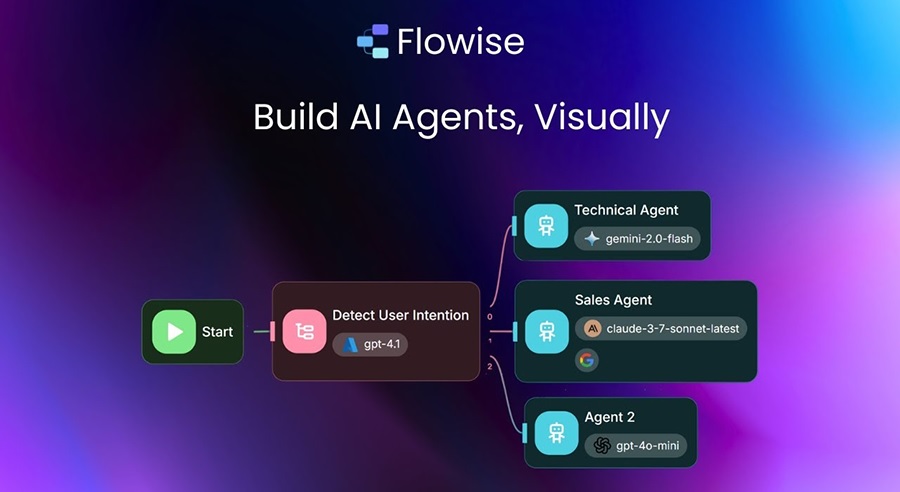
When starting with Flowise, one of the first decisions you’ll encounter is choosing which builder to use: Assistant, Chatflow, or Agentflow. Each builder is designed with different goals and audiences in mind. Some are geared toward beginners who want to get a project up and running quickly, while others offer advanced autonomy for teams aiming to build sophisticated AI-driven solutions. Picking the right builder can save time, reduce frustration, and set you up for long-term success. This article provides a detailed breakdown of each builder, their strengths and weaknesses, and practical examples of when to use them.
Contents
Why Multiple Builders?
AI workflows can range from extremely simple to highly complex. A small business looking for a chatbot to answer common questions has different needs than a global enterprise automating logistics across multiple systems. By offering three builders, Flowise avoids the trap of one-size-fits-all design. Instead, it provides an on-ramp for beginners and a pathway to scale into more advanced workflows as your needs grow.
👉 Sign up for a free Flowise AI account
The Assistant Builder
The Assistant builder is Flowise’s most beginner-friendly option. It allows you to set up a simple conversational agent quickly, without needing to configure every detail. For newcomers, it feels less like building and more like filling in the blanks. The builder provides sensible defaults and minimal setup requirements, which lowers the barrier to entry.
Strengths
- Extremely quick setup – ideal for testing ideas or prototypes.
- Requires little to no technical knowledge.
- Good for non-technical users such as support staff, marketers, or small business owners.
- Lightweight, so it runs efficiently even on modest infrastructure.
Limitations
- Limited customization – users cannot easily fine-tune advanced behaviors.
- Not designed for multi-step reasoning or workflows that need external integrations.
- Can feel restrictive for projects that outgrow basic functionality.
Best use cases
Quick prototypes, simple FAQ bots, lightweight assistants for small teams, and early experiments with AI workflows.
The Chatflow Builder
Chatflow strikes a balance between simplicity and power. It provides a visual, node-based interface where you can drag and drop components to design workflows. You can integrate data sources, control logic with branching paths, and customize prompts for more tailored agent behavior. This builder is well-suited for those who want flexibility without diving into full autonomy.
Strengths
- Visual interface makes it easier to understand complex workflows.
- Supports document loaders (PDFs, CSVs) and vector databases for knowledge-driven bots.
- Enables branching logic for handling different scenarios.
- Allows more customization of prompts and agent personality.
- Can integrate with APIs and external systems through connectors.
Limitations
- More complex than Assistant, requiring a learning curve for beginners.
- Still not designed for agents that need long-term planning or autonomy.
- May become cumbersome for very large projects with extensive logic.
Best use cases
Customer service chatbots, educational assistants, internal knowledge tools, and bots that query structured data sources.
The Agentflow Builder
Agentflow is the most advanced option in Flowise, designed for creating autonomous agents capable of planning, reasoning, and acting independently. These agents can chain together multiple steps, interact with external systems, and even make decisions about what tools to use in a given situation. This makes Agentflow ideal for enterprise applications where AI must go beyond conversation and into execution.
Strengths
- Supports advanced reasoning and decision-making.
- Integrates seamlessly with external APIs and custom tools.
- Capable of orchestrating multi-step workflows across systems.
- Scales well for enterprise-grade automation.
- Highly customizable for teams with technical expertise.
Limitations
- Steeper learning curve – requires technical knowledge to use effectively.
- More resource-intensive compared to simpler builders.
- Greater need for oversight to prevent unexpected or undesired outcomes.
Best use cases
Complex enterprise automation, logistics and supply chain systems, research assistants, and multi-tool orchestration for advanced business processes.
Comparison at a Glance
To summarize, here’s how the three builders compare:
- Assistant: Fast setup, minimal customization, best for beginners and simple tasks.
- Chatflow: Visual, flexible, good for mid-level complexity and integrations.
- Agentflow: Advanced autonomy, best for enterprise and highly complex workflows.
Decision Framework
If you’re unsure which builder to choose, consider the following framework:
- Timeline: Need something live today? Use Assistant. Have time to design and test? Use Chatflow. Building for long-term enterprise use? Agentflow is the way to go.
- Complexity: Simple chatbots work in Assistant, mid-complexity bots fit Chatflow, and advanced autonomous agents belong in Agentflow.
- Team expertise: Non-technical teams benefit from Assistant or Chatflow. Technical teams can maximize Agentflow.
- Scalability: If you plan to expand later, consider starting with Chatflow to allow a smoother transition into complexity.
Real-World Examples
- Retail: A small shop builds a simple Assistant bot to answer FAQs about store hours and return policies.
- Education: A university uses Chatflow to design a bot that helps students find courses, exam schedules, and policies.
- Logistics: A global shipping company builds an Agentflow solution to coordinate delivery schedules, manage inventory, and send real-time updates to customers.
Best Practices Across Builders
- Prototype quickly in Assistant before scaling.
- Keep flows modular and reusable, especially in Chatflow and Agentflow.
- Document nodes, flows, and logic clearly for team collaboration.
- Add human oversight for high-stakes or sensitive workflows.
- Test extensively – what works in one context may not scale to another.
Assistant, Chatflow, and Agentflow are not competing tools; they are part of a continuum. Flowise has designed them to meet users where they are, whether that’s creating a simple prototype or building enterprise-grade automation. The key is to match the builder to your goals, skills, and resources. Start small, learn as you go, and expand into complexity when the time is right. With the right builder, Flowise can help you unlock the potential of AI in ways that are both practical and scalable.

